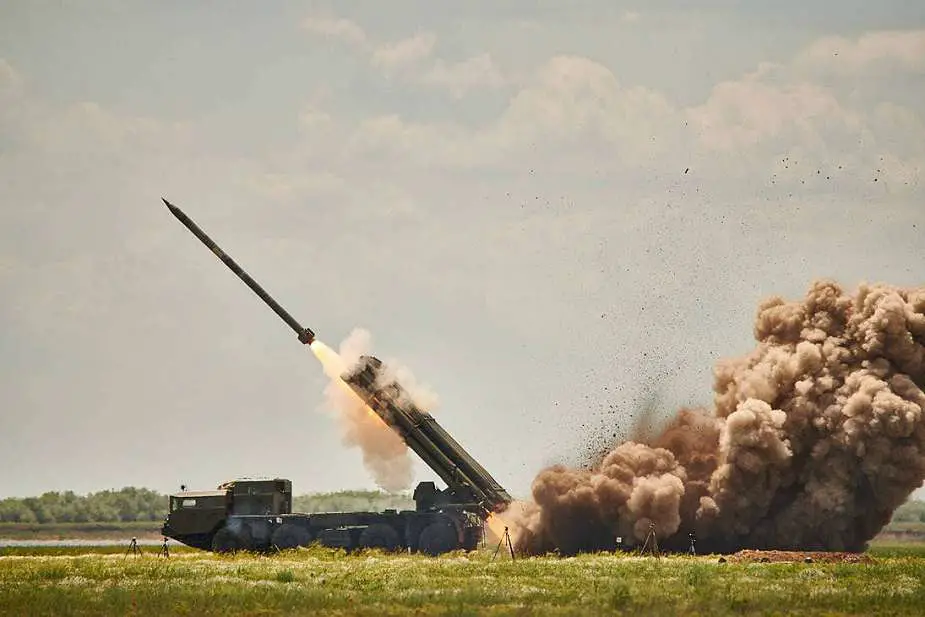- Army
- Conflicts in the world
- Israel - Iran conflict 2025
- Pakistan - India Conflict 2025
- Russia Ukraine War 2022
- Libya conflict day by day
- HAMAS - Israel War 2023
- Operation Serval in Mali French Army
- Sangaris operation Central African Republic
- Sangaris opération militaire République Centreafrique
- Ukraine - Russia conflict
- Syria conflict news
- Defence & Security Industry Technology
- Armies in the world
- Analysis Defense and Security Industry
- Conflicts in the world
- Navy
- Air
Ukraine Hits Russian Targets with Locally-Made Vilkha-M Rocket Launcher Surpassing US HIMARS in Range
Recent images on social media reveal the Ukrainian army's deployment of their latest locally-made Multiple Launch Rocket System (MLRS), the Vilkha-M. This addition significantly surpasses the capabilities of the GMLRS (Guided Multiple Launch Rocket System) rockets used in the M142 HIMARS, a system supplied by the United States. The Vilkha-M is notable for its extended range of 130 km and increased payload capacity, substantially enhancing the capabilities beyond the M142 HIMARS, which has a maximum range of 70 km.
Follow Army Recognition on Google News at this link

Archive Image: Firing test with the Ukrainian-made Vilkha MLRS Multiple Launch Rocket System. (Picture source Ukrainian MoD)
The Vilkha-M system's superior operational capabilities, with its ability to reach up to 130 km, set it apart. The rockets from Vilkha-M are designed to travel further and deliver a more powerful destructive force, a key aspect in modern warfare. This represents a strategic advancement over the M142 HIMARS system
According to reports from open sources, the Ukrainian Vilkha-M MLRS (Multiple Launch Rocket System) is reported to have been used in the controversial bombardment of the Russian city of Belgorod by Ukrainian Ground Forces in January 2024. Images on the Russian social network VK showed unexploded fragmentation warheads from 9N235 cluster warheads and debris from 300 mm R624-M rocket ammunition, indicating they were fired by the Vilkha MLRS.
The Vilkha's combat application by the Ukrainian Ground Forces has been notably observed since the beginning of the Russian invasion of Ukraine in 2022. Ivan Vinnyk, the first deputy head of the National Association of Ukrainian Defense Industries, confirmed on March 1, 2023, that the Vilkha had been actively used in combat since May 2022.
The introduction of Vilkha-M into the Ukrainian forces highlights the ongoing efforts to develop and integrate advanced military technology in the Ukraine conflict. It also demonstrates the country's commitment to enhancing its self-reliance in defense capabilities. The deployment of this system could potentially alter the tactical landscape of the conflict, offering Ukrainian forces a more robust and far-reaching artillery option.
This advanced rocket system, the Vilkha, is an evolution of the Soviet-made BM-30 Smerch and was officially adopted by the Ukrainian Army in 2018. Featuring a stabilization mechanism using two legs, the truck-mounted launcher is operated by a crew of four and is capable of launching all twelve missiles within a mere 45 seconds. The Vilkha is powered by a turbocharged diesel YaMZ-7511.10 engine, allowing for a top speed of 100 km/h. Its missiles are uniquely designed with micromotors, enhancing both range and in-flight stability, and it is equipped with both automatic and manual fire control systems.
The Vilkha's technological advancements include the use of a modified 9M55 rocket, capable of reaching up to 70 km with a 250 kg warhead. The upgraded R624 rocket integrates a new solid-fuel engine, GPS and inertial guidance, 90 small gas rudders for propulsion control, and aerodynamic vanes that activate during the final approach. This results in a circular error probable (CEP) of 10 m. The further refined Vilkha-M employs the R624M rocket, trading some warhead weight for an increased range of 130 km, although with a slightly reduced accuracy of 30 m CEP. Development efforts are underway to further extend the range of these projectiles.
News Russia Ukraine War


























